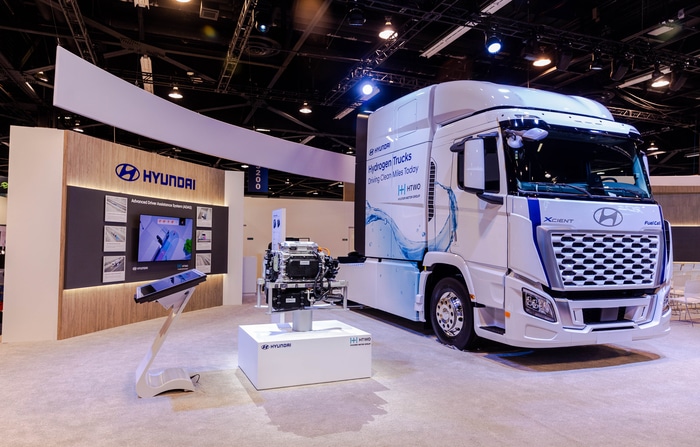At a time when North America’s heavy-duty trucking sector is under pressure to decarbonize, Hyundai Motor Company is positioning itself not just as a vehicle manufacturer but as a full-scale hydrogen infrastructure player. The automaker’s unveiling of its new Xcient Hydrogen Fuel Cell Truck and the HTWO Energy platform at ACT Expo 2025 reflects a deliberate pivot toward integrated hydrogen logistics in the U.S. market that merges hardware innovation with infrastructure scalability.
Trucking’s Decarbonization Dilemma: A Market in Flux
Heavy-duty vehicles account for nearly 25% of greenhouse gas emissions from road transport in the U.S., despite comprising only 5% of vehicles, according to data from the Environmental Protection Agency. With tightening state and federal emissions regulations—including California’s Advanced Clean Fleets (ACF) rule—fleet operators are scrambling for zero-emission solutions that don’t compromise long-haul capability.
Battery-electric trucks have made headway in local delivery and short-haul operations, but energy density, charging downtime, and weight penalties remain significant barriers for long-distance freight. Hydrogen fuel cell electric vehicles (FCEVs), on the other hand, offer fast refueling and longer ranges—two critical metrics for logistics operations spanning thousands of miles. Yet, adoption has remained sluggish without robust refueling infrastructure and proven vehicle platforms adapted to North American conditions.
Hyundai’s Xcient 2.0: Engineered for U.S. Terrain and Regulation
Enter Hyundai’s revamped Xcient Hydrogen Fuel Cell Truck, which now comes optimized for North American climates, road conditions, and driver expectations. While the company has not disclosed precise technical specifications at ACT Expo, it notes enhanced fuel cell output and the integration of advanced driver assistance systems (ADAS), including forward collision-avoidance assist and lane departure warning. These features will be crucial for compliance with U.S. Department of Transportation (DOT) safety standards, as well as for minimizing operational risks in fleet logistics.
The introduction of a 12.3-inch digital cluster and commercial vehicle-dedicated navigation also signals Hyundai’s bid to elevate the user experience in a segment traditionally resistant to rapid tech adoption. However, while these improvements respond to market demands, performance metrics such as range, payload capacity, and total cost of ownership (TCO) will ultimately determine whether the truck gains traction among U.S. fleet buyers.
HTWO Energy Savannah: Infrastructure as a Strategic Lever
Complementing the vehicle launch is Hyundai’s infrastructure strategy through the HTWO Energy platform, anchored by the HTWO Energy Savannah hub in Georgia. The facility’s initial 1,200 kg/day hydrogen production and refueling capacity—expandable to 4,200 kg/day—marks one of the more ambitious regional hydrogen logistics nodes announced to date. By comparison, many existing hydrogen stations in California serve passenger vehicles and provide less than 500 kg per day.
Crucially, the Savannah hub’s proximity to Hyundai’s $5.54 billion Metaplant America facility allows for vertically integrated logistics, reducing hydrogen distribution costs and enabling vehicle rollout coordination. Hyundai has also signaled the hub’s dual-functionality for hydrogen and electric charging, aligning with a broader “multi-energy” infrastructure trend. Yet, the absence of concrete partnerships with hydrogen producers or utilities suggests execution risk remains, especially given Georgia’s limited hydrogen ecosystem.
The Long Road Ahead: Ecosystem Coordination Will Be Key
Hyundai’s ambition to become a key architect of the North American hydrogen freight ecosystem is clear. But the company is entering a fragmented and politicized landscape. While states like California and New York are providing subsidies and regulatory mandates that encourage FCEV deployment, others remain tethered to fossil fuel interests and lack enabling policies.
Moreover, competitors such as Nikola and Toyota are already trialing hydrogen trucks with logistical partners on the U.S. West Coast. The speed and scale at which Hyundai can develop and operationalize its hydrogen corridor, especially outside established clean tech markets, will be the decisive factor. Ken Ramirez’s comment that Hyundai will work with “local partners as well as group companies” is promising but non-specific; investors and fleet customers will want more detailed blueprints soon.
From Vehicles to Value Chains
With its latest moves, Hyundai is making a case for vertical integration as a competitive differentiator in the zero-emission freight space. The launch of a U.S.-tailored hydrogen truck and a scalable hydrogen hub is not just a technological update—it’s a signal of Hyundai’s intent to reshape logistics value chains, not just serve them.
But in a market where pilot programs often fizzle before commercial scaling, the industry will be watching closely to see whether Hyundai’s hydrogen strategy translates into real-world adoption or remains confined to the exhibition floor.





